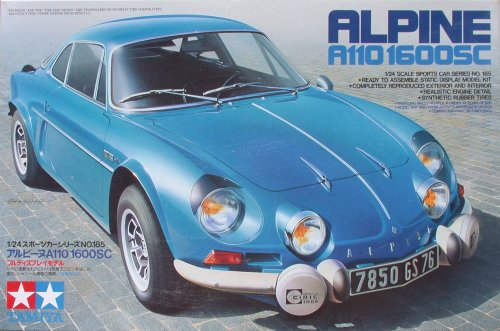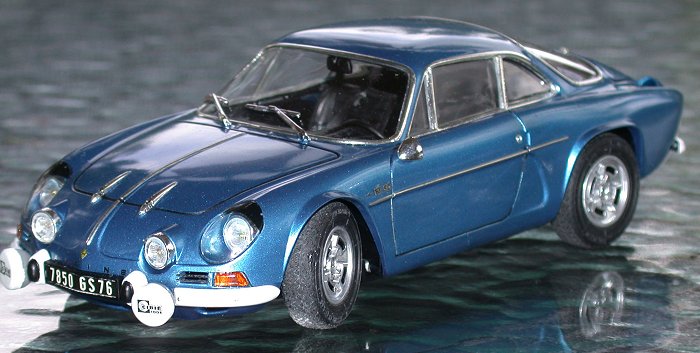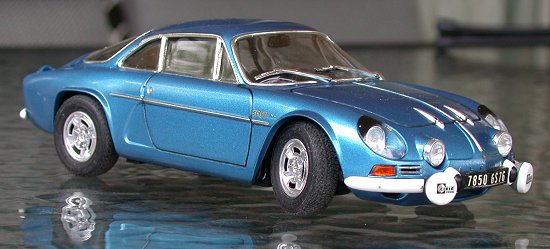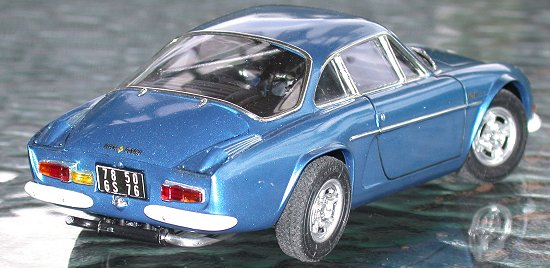
Tamiya 1/24 Alpine A110 1600SC
|
KIT # |
185 |
|
PRICE: |
AUD $40 |
|
DECALS: |
Two sets of plate options |
|
REVIEWER: |
|
|
NOTES: |
The kit is quite accurate: Seat Belts from Modeller's Products of Japan |

|
HISTORY |

Shortly after World War II most of the European car manufacturers were in all sorts of bother, with France suffering the worst. Parts were in short supply as was funding and few, if any of the smaller car manufacturers had survived the conflict. A few were able to rebuild their businesses after the war although this was not helped by the taxation system of the country imposing penalties for cars with engine displacements larger than 2.8 litres. Most of the big cars, like Bugatti, Delage, and Delahaye went to that great car garage in the sky. The cars that replaced these bigger pre-war vehicles also did not last long, leaving the sporting French drivers with little option but to purchase foreign cars or modify their existing Renaults, Simcas, Peugeots and Citroens.
The situation lasted into the mid 1950’s with French cars seldom winning Grand Prix races. The only vaguely sporting cars were manufactured by DB and Alpine. The DB, made by Deutsch and Bonnet, was powered by a less than earth shattering Panhard engine, whilst the Alpine was endowed with a 750 cc motor, again something that was not likely to get your pulse going! Yet these two marques were to become the backbone of the French racing manufacturers. The DB eventually became the Matra, with which Jackie Stewart won the 1969 World Championship, and the Alpine turned into the Alpine-Renault, which became an outstanding success on the rally circuits of Europe.
The Alpine was the brainchild of Jean Redélé, born in Dieppe in 1922, the son of a garage owner who ran a Renault agency. He obtained an engineering degree and returned to Dieppe to help his father. Following the war the business was destitute and survived by repairing farm machinery and other pre-war machinery, including motorcars.
Gradually the company regained its footing and Redélé started to think about competition motoring. At that time the only suitable car was the 4CV Renault – a tiny rear-engined four cylinder 750 cc salon that was the mainstay of millions of Frenchmen into the 60’s. To look at the car was not to invoke visions of chequered flags but Redélé extensively modified it, even to the extent of fitting a five-speed gearbox in an effort to extract better performance. This car was entered into all sorts of events, rallies, hill-climbs and races and not just local ones. Redélé entered the car into events that catered to his addiction of long distance affairs such as the Coupe des Alpes and the Mille Maglia. The Coupe des Alpes was also known as the Alpine Rally and was regarded as one of the most arduous of long distance rallies, a fact that is still true today although over shadowed by such events as the Paris to Dakar and the African Safari rally. The Mille Maglia is the famous 1,000 mile race around Italy and, although the little 4CV could hardly be expected to win such an event, was regularly placed as a class winner. Redélé actually won the 750 class for three consecutive years in 1952, ’53 and’54.
Redélé continued to build his cars through the 50’s eventually building a car to compete at Le Mans, the M63 designed by the British designer Len Terry. This car proved to be very successful in 1963 as was the car’s successor a year later, the M64. As the engines were small capacity units from Renault the cars could hardly be expected to win outright, they did do well in their class and ran consistently, especially at Le Mans. The M64 won its class at Le Mans, Rheims, Sebring and the Targa Florio. The M64 geared for Le Mans was capable of achieving 150 mph + and averaged over 100mph in winning it’s class.
The Berlinette A110 was introduced in 1963 and was still in production some ten years later. It underwent a variety of engine capacities. In 1969 Redélé decided to withdraw from racing and concentrate on rallying. This was in no small part due to his efforts being overshadowed by the French company Matra. He began to develop the faithful A110 and commenced using the Renault 16TS engine. Initially this car was capable of producing 130bhp @ 6,000 rpm, giving the little coupé a top speed of over 130 mph. In 1969 the Alpine had a clean sweep of the Coupe des Alpes and a promising third place in the Monte Carlo Rally. The following year they followed up with another third place in the Monte Carlo and three victories in the most gruelling rallies of the day, The Italian Rally, the Acropolis in Greece, and the Tour of Corsica. In 1971 Alpine won the International Rally Championship by a huge margin, thanks largely due to their works driver, Sweden’s Ove Andersson.
The subject of this review is the 1600cc four cylinder Renault powered car developing 160 bhp @ 7200 rpm with fuel being supplied by twin side draught 45mm DCOE Weber carburettors. The suspension is almost entirely that of the Renault R8.
|
THE KIT |
The kit is presented in a Tamiya box, with nice cover art and some photos of the real vehicle on the side. Parts are presented on four sprues in four colours: grey, metallic blue, chrome and clear with the body as a separate piece, also in metallic blue. The kit also includes rubber tyres, poly caps, decals and metal transfers along with a nice ten-page instruction sheet. It is a fairly standard Tamiya product.
 The instruction sheet is very
clear and calls for decals to be placed at appropriate construction stages. It
also lets the builder know that the car was usually painted in a very
distinctive colour called “Alpine Blue”. This became available from Tamiya
at about the same time the kit was released and is known as TS Alpine Blue. The
metal transfers are used for such things as the mirrors, grille work and the
badges on the sides, bonnet and boot (substitute hood and trunk if you’re from
the US, although I have yet to see an elephant get into the space reserved for
the back of the car – I know, poor joke!). The badges also get water-slide
decals placed over the metal ones, which is a bit of a novelty for me.
The instruction sheet is very
clear and calls for decals to be placed at appropriate construction stages. It
also lets the builder know that the car was usually painted in a very
distinctive colour called “Alpine Blue”. This became available from Tamiya
at about the same time the kit was released and is known as TS Alpine Blue. The
metal transfers are used for such things as the mirrors, grille work and the
badges on the sides, bonnet and boot (substitute hood and trunk if you’re from
the US, although I have yet to see an elephant get into the space reserved for
the back of the car – I know, poor joke!). The badges also get water-slide
decals placed over the metal ones, which is a bit of a novelty for me.
The clear parts are exceptionally clear and well laid out to allow for easy removal without the chance of damaging the part. I manage to stuff up these parts usually so this is a nice touch for my ham-fisted nature. The other parts have minor ejector pin blemishes and these have the usual locations designed to simply annoy the living daylights out of you – nothing that some simple skills can’t sort out and mine are pretty simple.
|
CONSTRUCTION |
This is the first part of the
construction, which comes as no surprise. What is a surprise is that the block
is supposed to be metallic blue and I decided to paint the entire engine in
Tamiya XF16, Flat Aluminium and then brush on Tamiya X23, Clear
 Blue. The engine is complete
with the gearbox and is mounted in a tubular frame that is also aluminium. This
part faithfully represents the central backbone chassis that is lightened for
competition purposes yet incredibly strong. It does not include the gear stick
as in the real model; this part is included in the cockpit construction.
Blue. The engine is complete
with the gearbox and is mounted in a tubular frame that is also aluminium. This
part faithfully represents the central backbone chassis that is lightened for
competition purposes yet incredibly strong. It does not include the gear stick
as in the real model; this part is included in the cockpit construction.
There is enough detail on the engine to build up into a fair representation of the real thing, however with the majority of my brethren (both ladies and gentlemen) there is no such thing as enough. In this case I decided to scratch build the distributor and attach the appropriate ignition leads. I also decided to ignore Tamiya’s instructions to paint the carburettors X11, Chrome Silver; these units are the famous Weber side draught carburettors and are a gold/silver colour. From personal experience (I had a set of twin 40mm DCOE Weber carburettors on my road going rally Datsun 1600 – sometime during the last millennia!), these units were upgraded with fuel lines and the air filters, individual venturi trumpets, were treated to some mesh to simulate the mesh filters used on the real car. The rubber attachments that connect the carbies to the manifold were painted Flat Black and the inlet manifold was painted Flat Aluminium, XF16. The air venturis were painted in Tamiya Chrome Silver, X11.
 Once the engine had been completed
it was added to the sub frame. This unit, as previously described, is of a
tubular construction and the engine is fitted from the underside, the whole sub
frame is painted with Tamiya Flat Aluminium, XF16. This unit has the
front and rear suspension attached and this is completed after the engine
installation. I waited until the engine was attached before connecting up the
carburettors and the extractors (exhaust system) along with the distributor.
These were likely to get knocked off during construction.
Once the engine had been completed
it was added to the sub frame. This unit, as previously described, is of a
tubular construction and the engine is fitted from the underside, the whole sub
frame is painted with Tamiya Flat Aluminium, XF16. This unit has the
front and rear suspension attached and this is completed after the engine
installation. I waited until the engine was attached before connecting up the
carburettors and the extractors (exhaust system) along with the distributor.
These were likely to get knocked off during construction.
The suspension is in the form of wishbones on the rear and a similar arrangement on the front. The arms were painted with Tamiya Semi Gloss Black, X18. The shock absorbers were painted semi gloss black with the springs painted with Tamiya Blue, X4. The discs were painted Tamiya Metallic Grey, XF56 and the callipers were painted black with the pistons in Tamiya Titanium Gold, X31. The brake assemblies are attached to the suspension and allowed to move. The wheels are allowed to rotate through the use of polycaps inserted between the discs and the brake housing. The steering also is moveable with the steering rod attached and not glued to the wheel sub assemblies.
Once all the suspension and engine had been attached to the sub frame the completed unit was set aside and eventually attached to the car under body, which included the attachment of the undertray, presented as a clear part and painted with Tamiya Semi Gloss Black, X18.
The Interior
As this car is a rally car the
inside is relatively Spartan, although when compared with today’s standard rally
car the fittings would appear quite extravagant. Most of the final pictures also
do not show the extra work put into this area, specifically seat belts complete
with photo etched buckles and attachment points, represented as a three point
racing harness as used at the time.
I used some generic seat belts from
Modeller’s, a Japanese aftermarket company, and in this case I u sed
the Racing Harness set (P501-1100) that also allowed the construction of the
belt webbing. The kit also has white metal fittings for the more modern style of
racing harness, similar to the seat belts used in modern aircraft. They’re there
honest; just have a close look at the figure below:
sed
the Racing Harness set (P501-1100) that also allowed the construction of the
belt webbing. The kit also has white metal fittings for the more modern style of
racing harness, similar to the seat belts used in modern aircraft. They’re there
honest; just have a close look at the figure below:
The instrument panel is presented as a set of decals that were covered with Testors Clear to give some reality. The dashboard is painted with semi gloss black with the instrument surrounds and the highlights on the dash painted with Chrome Silver, X11. The steering column and wheel were attached to the dashboard. The latter had the metal portions drilled and painted in Chrome Silver, X11. A decal was attached to the horn button. Both seats were painted in a mix of semi gloss and flat black as per instructions. The rear parcel shelf, also a cover for the engine, was installed and then the roll cage, the singular most important piece of any rally, or competition car for that matter. This unit was painted in semi gloss black and both seat belt harnesses were attached to the cage. Both side panels were painted in a mixture of body colour and semi gloss black with chrome silver highlights for the door handles and window winders.
|
PAINTING & DETAILING |
The Body
 The body has been painted with a
paint especially prepared by Tamiya for this kit called Alpine Blue and
is available in a spray can, TS Alpine Blue. This is a metallic blue and is the
colour of the original Alpines. Once the body was painted the parts to be
painted with chrome silver were covered with Bare Metal Foil Ultra
Chrome. This included the window surrounds for front and rear screens, the side
window trim as well as a body stripe down both sides. In addition the air
intakes situated at the rear on the car on each guard were sprayed with Alpine
Blue and then covered with foil.
The body has been painted with a
paint especially prepared by Tamiya for this kit called Alpine Blue and
is available in a spray can, TS Alpine Blue. This is a metallic blue and is the
colour of the original Alpines. Once the body was painted the parts to be
painted with chrome silver were covered with Bare Metal Foil Ultra
Chrome. This included the window surrounds for front and rear screens, the side
window trim as well as a body stripe down both sides. In addition the air
intakes situated at the rear on the car on each guard were sprayed with Alpine
Blue and then covered with foil.
The rear lights were painted clear red and orange as per the instructions with Bare Metal Foil being added to simulate the reflector of each lens. The front lights were painted with Tamiya Clear Yellow X24 representing the globe and the clear lens placed on the chrome surround and cemented to the body. In addition to the normal headlights the kit is supplied with auxiliary lamps, also with a clear yellow globe, and two Cibie driving lights. The Cibie lights are some of the best driving lights in the world and the ones fitted to the Alpine were called Oscars. They are represented with the standard white lens cover and a decal is used for the manufacturer. A clear cover covers the main headlights and attached to this over the top is a black decal. The front indicators were painted clear orange and the recess for each light was covered with Bare Metal Foil.
|
FINAL CONSTRUCTION |
 Two bumper bars are attached to
the front and rear of the car and these, although instructed to be silver, were
painted white. Two metal decals are attached to the front of the body, one
depicting the car manufacturer, ALPINE and the other being the diamond shape of
Renault, the latter is also covered with a water slide decal of Renault. The
rear engine cover (or hood instead of boot as the engine is in the rear of the
car??) has a similar decal with the combined name of “Alpine Renault” separated
by the Renault car symbol as on the front. The rear engine cover is removable
with the hinges being covered with Bare Metal Foil, as are the ones on
the front of the bonnet.
Two bumper bars are attached to
the front and rear of the car and these, although instructed to be silver, were
painted white. Two metal decals are attached to the front of the body, one
depicting the car manufacturer, ALPINE and the other being the diamond shape of
Renault, the latter is also covered with a water slide decal of Renault. The
rear engine cover (or hood instead of boot as the engine is in the rear of the
car??) has a similar decal with the combined name of “Alpine Renault” separated
by the Renault car symbol as on the front. The rear engine cover is removable
with the hinges being covered with Bare Metal Foil, as are the ones on
the front of the bonnet.
The final touches were the addition of the windscreen wipers and the driver’s side mirror. The wiper blades were painted Flat Black to simulate the rubber. Voila! An Alpine Renault rally car!
|
CONCLUSIONS |
This was a great kit to build and
despite our editor alluding to my descending the “slippery slope” of car
building I thoroughly enjoyed this model. Actually the editor is not aware of my
past connection with rallying and didn’t realise just how close he really was
with his “slippery slope” remarks. (In his youth, your editor was part owner
of a dirt track racer; a 57 Chevy with a 2 barrel 283 and no bodywork forward of
the firewall, that he thoroughly enjoyed flogging around the 1/5 and 1/4 mile
'bull rings' that dot this part of the country. No, he wasn't that good, but did
enjoy himself immensely. Ed). I enjoy building car kits
 as a break from my
passion of aircraft, interspersed with the occasional motorcycle and sometimes
ship!
as a break from my
passion of aircraft, interspersed with the occasional motorcycle and sometimes
ship!
Tamiya have made a great kit and one that is very easy to construct. The idea of bringing out a specific spray paint in which to finish this car is a very clever idea and gives the car an accurate colour finish that would have otherwise been difficult. It is one of the kits that we come to expect from this manufacturer, even with the usual gripes about ejector pin marks and lack of paint choice. The time for construction was relatively short with the majority of time spent in getting the article written.
Will I build another car kit? Yes, with no doubts whatsoever and in a few other scales to boot. I love the diversions presented by such kits and find them a challenge in different ways from my usual builds. They can certainly be upgraded with extra bits and a web search will reveal after market companies who specialise in cars for those who want to go that little bit extra. Companies such as Fujimi who produce a variety of parts including brake lines, plug cords and garage figures to complete the diorama, should the modeller wish to go to such lengths.
|
REFERENCES |
Alpine The Rally Car – French Style On Four Wheels, Orbis Publications, The Great Cars/Alpine pps 61-64
Rally Cars Given The Works, Robson, G. Editor (Autocar), Temple Press1983, ISBN: 0 600 35050 9
If you would like your product reviewed fairly and fairly quickly, please contact the editor or see other details in the Note to Contributors.
Back to the Reviews Index Page